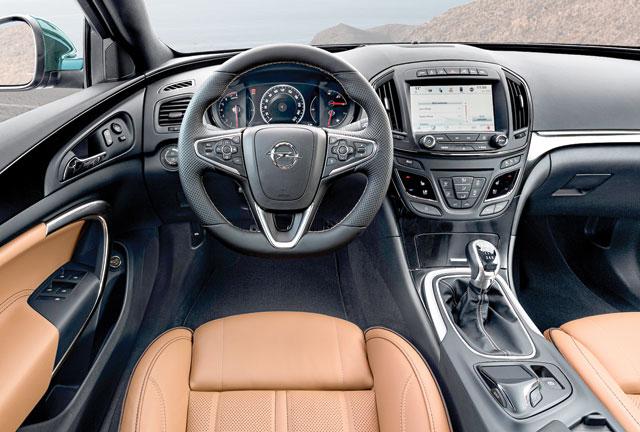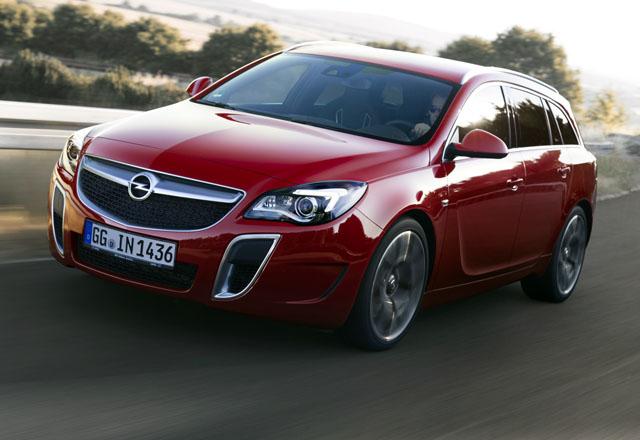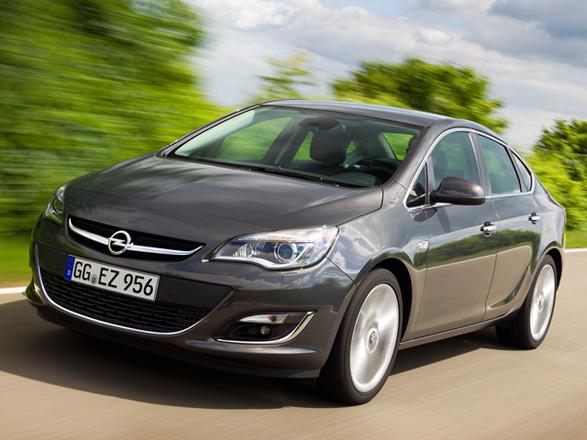You are here
Refined refresh
By Ghaith Madadha - May 18,2015 - Last updated at May 18,2015

In reaction to the 2008 financial crisis, General Motors was close to selling its German Opel brand. But given its position as engineering and vehicle development powerhouse and as makers of the automotive giant’s most consistently good cars, clearer heads prevailed and Opel remained in the fold.
Launched in the same year as the crisis, the Opel Insignia is one such vehicle. Replacing both the long-running Vectra mid-range saloon and short-lived Signum, the Insignia is a more refined, luxurious, technologically advanced and better designed successor, with a broad range of engine, equipment and body styles to choose from.
Flowing face-lift
Face-lifted since the 2014 model year, the Insignia’s exterior and interior design has been sharpened up. Also, improved and new tech, equipment and engines were added to the range, including the efficient and muscular 1.6-litre SIDI engine featured here.
Aesthetic revisions are subtle, but add up to a classier and smarter look with more up-market presence. Most prominent among the revisions is a wider grille with a more prominently jutting Opel lightning rod emblem and large top slat. Also changed are the headlights, which with revised LED elements and narrower inside look more charismatic and assertive.
Discrete and elegant, the Insignia nevertheless features a more sculpted design and body surfacing than its predecessors. With sharp centre bonnet crease, muscular side L-shaped moulding, subtly muscular wheel-arches and riding on larger wheels, the Insignia’s refreshed bumper designs lend it a more dynamic sense of flow in front and an up-tilted yet road-hugging appearance from the rear.
Revised rear lights and a long inter-connecting chrome strip also seem to bring out the best in the 5-door hatchback version driven. With long descending roofline and large lift-back rear, the Insignia hatch offers both a more flowing profile and practicality than its four-door saloon sister.
Muscular and frugal
Developing 168BHP at 4250rpm and 192lb/ft torque throughout a broad flexible 1650-4250rpm mid-range, the front-wheel-drive Insignia 1.6 is responsive off-the-line, while power build-up is underwritten by abundant torque. Accelerating from standstill to 100km/h in 9.2-seconds, the Insignia can keep going until 220km/h.
Smooth, responsive and with muscular low- and mid-range capability for flexible in-town driving and effortlessly versatile on-the-move acceleration, Insignia 1.6 confidently kept up with more powerful and faster traffic. Decisive and refined on Germany’s de-restricted high speed Autobahn, the Insignia 1.6 was happy to consistently carry speeds of 180km/h and above.
Though it loses 10BHP to the pre-face-lift Insignia’s 1.6-litre Turbo Ecotec engine’s output, the newer 1.6-litre turbocharged direct injection SIDI makes up the difference with an additional 12lb/ft and lower, more responsive and better exploitable torque band. Lower-revving and fitted with a stop/start system, it is also significantly more efficient and with a large 70l fuel tank, delivers long refuelling range.
With 5.9l/100km combined fuel consumption, compared to its predecessor’s 7.7l/100km. Similarly cleaner than the pre-facelift 1.6-litre model, the new SIDI engine emits just 139g/km CO2, compared to 181g/km, as fitted with standard 6-speed manual gearbox, as tested. The Insignia 1.6 manual features light and intuitive clutch, while its gear lever clicks easily through ratios.
High speed stability
A progressively larger and more refined successor to the Vectra mid-size saloon, the Insignia excels at the large car attributes that Opel has always done well. In fact, the Insignia is so reassuringly stable, luxuriously refined and comfortably smooth, that it also simultaneously serves as somewhat of a successor to Opel’s last great rear-drive executive Omega saloon, which ended production in 2003.
At its best on the motorway, the Insignia has a planed, stable and buttoned down, but smooth ride quality. A committed and reassuring high speed long distance cruiser with good directional stability, the Insignia makes short work of sustained speeds on the Autobahn.
Riding on MacPherson front and multi-link rear suspension, the Insignia can also be fitted with adaptive magnetic dampers for greater comfort and handling focus. However, driven with standard suspension with 225/55R17 tyres, the Insignia’s ride was forgivingly comfortable and smooth yet well controlled through corners and settled on vertical rebound.
Balanced between handling ability and ride quality the lighter four-cylinder Insignia 1.6-litre corners more eagerly and tidily than heavier V6 and diesel versions. Its tyre size allows for decent road feel and comfort as well as high grip levels, and drove with good control, agility and manoeuvrability through country lanes.
Cabin comfort
With good visibility, comfortable and well adjustable seats and steering, and generous front space, the Insignia is easy to place on the road and relaxing to drive for long distances. Well refined from noise, vibration and harshness, the Insignia also features good rear space and a generous luggage capacity. Easily accessible through its long rear hatch, the Insignia’s boot accommodates a minimum 530-litre volume.
Well-fitted and finished with quality materials and soft textures, the Insignia has refined if somewhat business-like cabin environment. Reducing the number of buttons and moving many functions to new infotainment touchscreen lends the face-lifted Insignia’s cabin a more sophisticated and classier feel.
Logically laid out and refined inside, the Insignia comes thoroughly well equipped with standard and optional convenience, infotainment and safety equipment, starting with its 8-inch touchscreen and touchpad accessible infotaiment system. The insignia range also features climate control, USB and Bluetooth enabled sound system, heated seats, keyless entry and numerous other standard and optional features.
Safety and convenience equipment available includes parking assistance and front and rear cameras, dual-stage and side curtain airbags, hill start assistance, electronic stability control, ABS and electronic brakeforce distribution. Driver assistance systems available include adaptive cruise control, adaptive lighting, lane departure warning, traffic sign assistance and rear cross-traffic, forward collision and blind spot alerts.
TECHNICAL SPECIFICATIONS
Engine: 1.6-litre, transverse, turbocharged 4 cylinders
Bore x stroke: 79 x 81.5mm
Compression ratio: 10.5:1
Valve-train: 16-valve, DOHC, variable valve timing, direct injection
Gearbox: 6-speed manual, front-wheel drive
Power, BHP (PS) [kW]: 168 (170) [125] @ 4,250rpm
Specific power: 105.1BHP/litre
Torque, lb/ft (Nm): 192 (260) @ 1,650-4,250rpm
Specific torque: 162.7Nm/litre
0-100km/h: 9.2 seconds
80-120km/h, fifth gear: 10.3 -seconds
Top speed: 220km/h
Fuel consumption, urban/extra-urban/combined: 7.5-/5-/5.9 litres/100km
CO2 emissions, combined: 139g/km
Fuel capacity: 70 litres
Length: 4,842mm
Width: 1,858mm
Height: 1,498mm
Wheelbase: 2,737mm
Track, F/R: 1,587/1,590mm
Kerb weight: 1,571kg
Luggage, min/max: 530/1,470 litres
Payload: 507kg
Steering: Variable-assist rack & pinion
Turning radius: 10.9 metres
Suspension, F/R: MacPherson struts/multi-link
Brakes, F/R: Ventilated discs/ discs
Tyres: 225/55R17
Related Articles
A large utilitarian family car well-suited for the Ikea-run and rock-steady high performance Autobahn-stormer, the Opel Insignia OPC Sports Tourer benefits from the cargo space and four-wheel-drive traction of an SUV and the driving dynamics, handling and ride refinement of a sports saloon.
A new addition to Opel’s mid-size Insignia saloon and estate, the Country Tourer is a raised four-wheel drive estate version, designed for the sort of modest off-road ability one might require in real world driving.
First introduced in 2009 and face-lifted in 2012, the Opel Astra “J” series may have been replaced in European and other markets by a succes


















